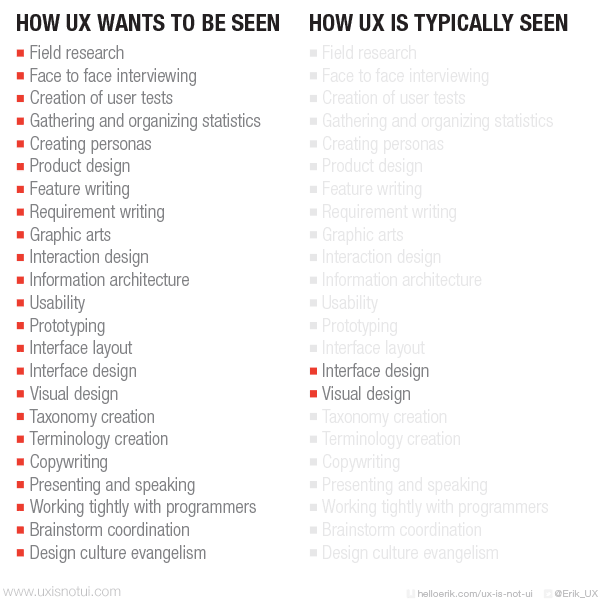Last year I spoke to a UX practitioner who worked with open source projects and companies to better understand why UX was underrepresented in open-source software. She cited three reasons: (1) different OSS governance structures; (2) code contributions being considered more valuable and (3) a fundamental misunderstanding of UX. (You can read the full post here.)
In my own observations and conversations with developers and marketers, UX design is often conflated with visual design or user interface design, when in fact both of these are sub-disciplines within the field of UX design and are not representative of the totality of UX. I've been involved in conversations where talk of updating a "page's UX" has meant adding visual design elements to a page. Anecdotally, I've seen calls for "UX designers" in open source when the need was for brand assets like a logo. (In this case, you would look for a visual designer.)
In this short post, I'll cover some basics of UX design for developers who are interested in understanding what UX is and how it differs from other forms of design.
What is UX design? (The TLDR)
The term "user experience" was coined by Don Norman, author of The Design of Everyday Things. His definition of UX is as follows: "user experience encompasses all aspects of the end-user's interaction with the company, its services, and its products". Let's apply this to a company, like Gatsby. A developer has multiple touchpoints with Gatsby (the company) and its products, including (1) using the official documentation to get started (2) installing the open-source version (3) writing commands in the CLI to deploy your Gatsby blog (4) looking at the Gatsby marketing website to understand their features (5) error messages and more. Everything from the email campaign you get when you created an AWS account to the messages and in-app notifications you get when you sign into Dropbox are all part of the user experience.
The first user experience designers were engineers, cognitive scientists, psychologists, and librarians. And all of these different disciplines helped propel the field forward. In fact, what we call "UX design" is actually an umbrella term for many different interrelated fields. You can see this in the main image above and there are other visual representations that illustrate the various disciplines that roll into UX design:
In the image above you'll observe areas of overlap between different fields. This is but one visual representation of UX; there are many others. To get a better understanding of the differences between titles like UX designer, product designer, visual designer, and UI designer, read this article.
UX vs Visual vs Interaction Design
I believe that there are many reasons why there seems to be confusion about UX disciplines. As I mentioned above, UX is an umbrella term for dozens of sub-disciplines, many of whom overlap depending on the context. Additionally, the role of UX design has evolved in many SaaS environments to the point where many UX designers have to be very good visual designers. (Some UX designers started out as visual designers.) Here are some definitions provided by Marty Cagan's book Inspired:
"Interaction design includes the underlying conceptual models, task flows, and control layouts to manipulate those concepts."
"Visual design includes composition, typography, and how the visual brand is expressed."
And here's a definition of user interface (UI) design according to the Interaction Design Foundation:
- "User interface (UI) design is the process of making interfaces in software or computerized devices with a focus on looks or style. UI design typically refers to graphical user interfaces but also includes others, such as voice-controlled ones."
To further complicate things, designers today may engage in other UX activities, such as user research, usability testing, product discovery, UX writing, and information architecture, among others. Product designers especially are typically responsible for visual, interaction, and interface designs while also engaging in user research and even copywriting. But this isn’t true for other types of designers (like visual designers).
Why is this confusing? Is it even necessary? As UX continues to evolve, new roles emerge with changes in scope of work and associated responsibilities. New titles are created to express the differences and nuances between interrelated fields. There may be some overlap in deliverables, but not all activities and processes are the same.
Developer Experience is UX
I recently learned that some companies use titles like "DevEx" to differentiate between UX, and that DevEx includes things like API design, CLI design, UX writing for developer tools (like error messages, man pages, commands, etc) and even technical writing.
DevEx professionals also use design thinking processes to create solutions for their end-users (who happen to be developers) and they frequently talk to their customers and users (user research). With that understanding, we can see how DevEx falls into user experience, as UX isn't limited to user interactions with a graphical user interface (GUI).
In summary, UX design and UX activities aren’t limited to any one field or discipline. User experience is a journey that every team plays a part in creating: marketing, engineering, product, technical writing, design. UX for dev tools will look markedly different than UX for a B2C product, but both nevertheless rely on design thinking, understanding users, and the various touchpoints users have with their product.
Want to learn more about UX design and UX tools? Check out the Pocket UX list for more resources.
This post was originally published on my blog.
I'm Stephanie, a Content Strategist and Technical PM. Visit developersguidetocontent.com to learn more about my work!









Oldest comments (0)